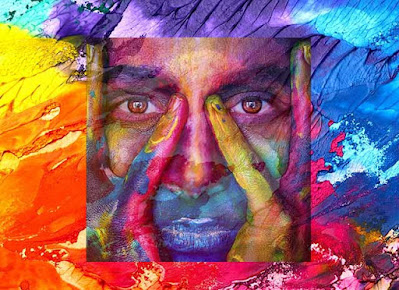
There are some fantastic facts about colors we all get wrong. For example, the sun's color is yellow, or we see black at night or when we close our eyes. We wrongfully think gold is gold, water is colorless, and there are 7 colors in the rainbow. It is a scientific fact about color that the conjecture act of seeing color is more complex than we think. Science, the brain, eyes, and even language determine how we see colors. We only see colors we've names for. It means colors without names usually get misidentified. One well-known color is blue, but you know it was called green for most of history. Blue is not a single color with a controversial and questionable history.
10- What Color Do We See When We Close our Eyes?

What color do we see when we close our eyes or at night? Do you think it's black? No! You are wrong. It is called eigengrau. Eigengrau (also called Eigenlicht, dark light, or brain grey) is a German word that means intrinsic grey or own grey. Eigengrau is a little brighter than black. In hex code, it is represented by code #16161d for graphic designers. The German physicist, Gustav Theodor Fechner, proposed that we saw eigengrau in place of black when we closed our eyes or at night in the 19th century. Before then, all the people believed that we saw black.
9- The Color Pink Doesn't Exist

There is a continuing debate over whether the color pink exists. Some scientists say it doesn't; others say it exists. Anyway, we all see the color pink. How is this possible that we could see color, but that color has no existence?
The fact is: that pink light doesn't exist; the color pink exists. We usually believe that each color has a corresponding wavelength of light. i.e., every color in presence appears in the rainbow. (But the question can be raised why black and white do not count. Don't worry. I am here to answer this; because they are not considered colors). This is incorrect. The Colour pink does not appear in the rainbow, nor does it have a corresponding light wavelength. Pink light can only be in nature if the red light in the rainbow crosses the pathway with violet. However, that will never occur since red and violet are at opposite ends of the rainbow. Both will never meet unless some powerful sorcery alters the composition of colors in the rainbow.
8- There Are 7 Colors Of Rainbow?


Do you know how many colors there are in the rainbow? Ancient societies had different answers. Homer (the Greek author) said the rainbow had just one color, and that is purple. Xenophanes (the Greek philosopher) said the rainbow had three colors: red, yellow-green, and purple. In the period between the 1300s and 1600s, everyone agreed the rainbow had four colors; yellow, red, blue, and green, then later added purple as a fifth color. In modern days, everyone else thinks it is six or seven. However, the Chinese people still swear by the five-color rainbow. After reading this, you should wonder why people have different answers about how many colors we have in the rainbow. It should not be hard to fix (determination). Anyway, everyone sees the rainbow.
So the correct answer is; that it depends on whoever is counting. No precise edges depart the colors, so everyone sees whatever color they have a name for. A man or woman with a broad knowledge of colors could see hundreds of colors, while a man or woman with limited or less understanding of colors will always come up with less than 7. Sir Isaac Newton claimed the current 7-color rainbow in 1666. People thought the rainbow had 5 colors. Though Sir Newton bought everything in the universe that existed in the sevens. There were seven planets (Pluto and Uranus had not been discovered in Newton's time), seven days a week, and seven notes in the musical scale. Therefore, mistakenly, he assumed the rainbow should have 7 colors.
7- Water Has No Color?

Another mind-blowing fact about color is watercolor. Everyone thinks water is odorless, tasteless, and colorless. The first two are correct, but the third one is wrong. Pure water has a light blue color. This light blue tint(a mixture of color with white) is not the same as we see in the ocean. The ocean looks blue because water particles absorb longer wavelengths that are; red, orange, and yellow, and reflect lights of the shorter wavelength, which are; blue in this case. The same reason the sky is blue, just in time. It is the environment that reflects and absorbs the light. It is not possible to find pure water in nature because natural water will never contain impurities like sediments and minerals. Pure refined water could be created under controlled circumstances in the lab. The water will look colorless, but we realize blue-tint if we have much of it.
Another theory; A well-known Muslim scholar Ahmed Raza Khan claimed after his research that water has a black color. A different black.
You may also read: Why We Don't Give Water To Newborn Baby?
6- The Color Of Gold Is Gold?

The answer is yes - no, but not like you are thinking. It is a crazy fact about color that, in the beginning, gold or the color gold is a shade of yellow. Therefore, gold is yellow. Although gold is supposed to have a silvery color, like silver. Gold looks this way because of relativistic quantum chemistry.
5- Space Has Many Colors?

Everyone thinks space is colorful, especially when they see pictures taken by space agencies. If you meet scientists who have been to space, they will tell you it is way more tedious than you think. There is not much to see except the random dots of light. You will see nothing colorful either if you see it from a telescope, holding many heavenly bodies release lights behind the wavelengths we can see. That is not nearly always red and blue, which remain the two most basic colors in nature (universe).
The question is, from where do those colorful pictures come? Hold on to your heart, and take a deep breath; every image you have seen of space or some other heavenly body, like comets and plants or exploding stars, etc., is artificial (fake). Before you close this site, I would like to clarify that the pictures are accurate. It is a color that is not real (fake). The National Aeronautics and Space Administration adds color to its images to prominent features of interest, allows us to see lights that would have been impregnable to us, and mend our interest. Seeing dull, blackish, blue, and red pictures from space will get boring. Therefore, NASA regularly adds colors like green, orange, and purple to make it look nice and cool.
4- Humans Can See All Color In Existence

This is also wrong. There are at least 2 colors we will never see, regardless of how hard we try. These colors are blue-yellow and red-green. Red-green is not like greenish-red, reddish-green, or red and green. It is about between red and green. Think of it as a single color that is half green and half red. This applies to blue-yellow, too.
This becomes an issue when that cell sees something that is red-green. It can't become inhibited and excited. Therefore, it ignores the color. The same goes for yellow-blue. The cell that becomes excited about viewing yellow becomes deterred by seeing blue. Consequently, we can't see something that is yellow-blue unless.
Sleeping Tips For Good Night's Sleep
Blue-yellow and red-green are known as forbidden colors. We can't see them because of our eyes and brain working system. Human eyes determine the color of things using cells (opponent neutrons). These cells become inhibited or excited depending on the color they are viewing. The same cell that becomes stimulated on recognizing red becomes inhibited on viewing green.
3- We Can't Create/Imagine New Colors

Everyone should know all colors in existence. Every color is based on the 3 primary colors; red, blue, and yellow. But this is not true. It is possible to invent and create new colors. We have invented at least 3 new colors; YInMn Blue, also known as Oregon Blue, Mas Blue, Yin Min Blue, Vantablack, and NTP yellow(Niobium Tin Pyrochlore yellow).
Oregon Blue was first invented in 2009 by Professor Mas Subramanian. NTP Yellow was created by Simon Boocock in 2010 for the Shepherd Color Company.
Vantablack is too black. Unlike other colors, which alter the way light bounces off a thing(object), Vantablack absorbs light, making it resemble more like a black hole than a pigment (material that changes the color of reflected or transmitted light as the result of wavelength-selective absorption). It was claimed by Surrey NanoSystems.
2- All We See The Same Colors

Specifically, everyone may not recognize all the same colors when they stare at the same object or thing. Scientists consider that color perception may not be decided in advance as many have thought for hundreds of years. Many people have 3 different photoreceptors in their eyes that perceive green, blue, and red. Our eyes can physically perceive millions of colors. But we do not all recognize specific colors in the same way. Some people can not see color variations; they are called color blindness. Because of the absence or defect of the cells in the retina, sensitive to significant levels of light: the cones. But the frequency and quantity of these cells also differ across people with normal vision, making us all experience the same color slightly differently.
1- Do You Think The Sun Color Is Yellow?

It is not true that the sun is yellow. Do you know the sun is pure white? We can recognize the actual color of the sun when we break down its light using a rectangular prism or triangular. We will notice the color give out into the colors of the rainbow. If we turned back the process and mixed these colors together, there would be white. It is hard to believe, but technical things are sometimes hard to believe. If I go with technical details, you will be bored. So, accept the truth. Isn't it a mind-blowing fact about color?
